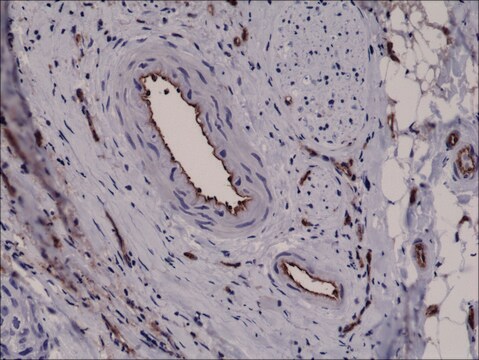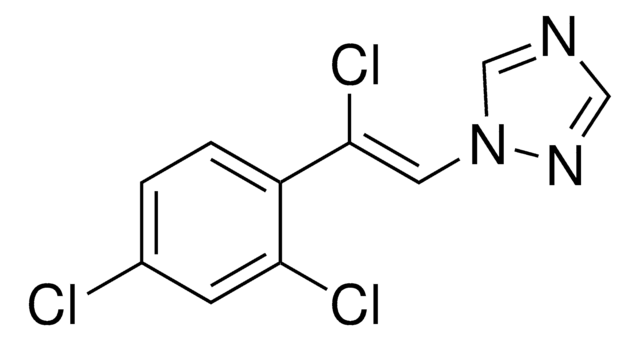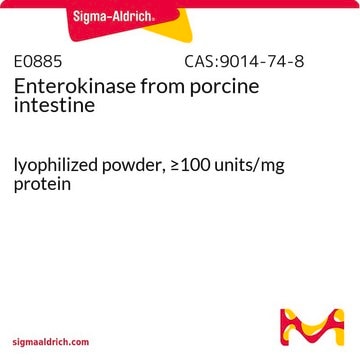推荐产品
生物源
rat
品質等級
抗體表格
purified immunoglobulin
抗體產品種類
primary antibodies
無性繁殖
390, monoclonal
物種活性
mouse
技術
flow cytometry: suitable
immunofluorescence: suitable
immunoprecipitation (IP): suitable
neutralization: suitable
同型
IgG2aκ
NCBI登錄號
UniProt登錄號
運輸包裝
ambient
目標翻譯後修改
unmodified
基因資訊
mouse ... Pecam1(18613)
一般說明
Platelet endothelial cell adhesion molecule (UniProt Q08481; also known as CD31, PECAM-1) is encoded by the Pecam1 (also known as Pecam, Pecam-1) gene (Gene ID 18613) in murine species. PECAM-1 (CD31) is a 130-kD cell adhesion molecule that is expressed at the junctions of all continuous endothelia, as well as most bone marrow-derived hematopoietic cells, including platelets, monocytes, granulocytes and some lymphocytes. The human PECAM1 and murine Pecam1 genes both produce multiple spliced isoforms with varying lengths in cytoplasmic domain, with the isoform Long being the major form expressed in human tissues and endothelial cells (ECs), and isoform delta 14-15 being the predominantly expressed murine form. PECAM-1 plays an import role in maintaining vascular integrity and function by mediating ECs interactions with pericytes and smooth muscle cells (SMCs). PECAM-1 is initially produced with a signal peptide (human a.a. 1-27, murine a.a. 1-17) sequence, the removal of which yields the mature protein with a large extracellular region (human a.a. 28-601, mouse a.a. 18-590) composed of six C2-type Ig-like domains, followed by a transmembrane seqment (human a.a. 602-620, mouse a.a. 591-609) and a cytoplasmic tail (human a.a. 621-738, mouse a.a. 610-727) that plays an essential role in PECAM-1-mediated cellular signaling.
特異性
Clone 390 immunoprecipitated the characteristic 120-130 kDa protein from L-cells transfected with muPECAM-1∆12,15 and selectively stained murine vessels in acetone-fixed tissue sections (Baldwin, H.S., et al. (1994). Development. 120(9):2539-2553).
免疫原
Epitope: extracellular domain
Mouse leukocyte cell line 32D.
應用
Flow Cytometry Analysis: A representative lot detected the expression of wild-type, ∆12,15 and ∆14,15 murine PECAM-1 constructs on the surface of transfected mouse L-cells (Baldwin, H.S., et al. (1994). Development. 120(9):2539-2553).
Immunofluorescence Analysis: A representative lot localized PECAM-1 immunoreactivity by fluorescent immunohistochemistry staining of murine embryo cryosections (Baldwin, H.S., et al. (1994). Development. 120(9):2539-2553).
Immunoprecipitation Analysis: A representative lot immunoprecipitated the 120-130 kDa exogenously expressed PECAM-1 ∆12,15 construct from transfected murine L-cells (Baldwin, H.S., et al. (1994). Development. 120(9):2539-2553).
Neutralizing Analysis: A representative lot inhibited the aggregation of murine L-cell transfectants expressing wild-type and ∆12,15, but not ∆14,15, murine PECAM-1 constructs (Baldwin, H.S., et al. (1994). Development. 120(9):2539-2553).
Clone 390 is also available as FITC conjugate (Cat. No. CBL1337F) for direct immunofluorescent staining in flow cytometry, immunocytochemistry and immunohistochemistry applications.
Immunofluorescence Analysis: A representative lot localized PECAM-1 immunoreactivity by fluorescent immunohistochemistry staining of murine embryo cryosections (Baldwin, H.S., et al. (1994). Development. 120(9):2539-2553).
Immunoprecipitation Analysis: A representative lot immunoprecipitated the 120-130 kDa exogenously expressed PECAM-1 ∆12,15 construct from transfected murine L-cells (Baldwin, H.S., et al. (1994). Development. 120(9):2539-2553).
Neutralizing Analysis: A representative lot inhibited the aggregation of murine L-cell transfectants expressing wild-type and ∆12,15, but not ∆14,15, murine PECAM-1 constructs (Baldwin, H.S., et al. (1994). Development. 120(9):2539-2553).
Clone 390 is also available as FITC conjugate (Cat. No. CBL1337F) for direct immunofluorescent staining in flow cytometry, immunocytochemistry and immunohistochemistry applications.
Research Category
Cell Structure
Cell Structure
This rat monoclonal Anti-PECAM-1 Antibody, clone 390, Cat. No. CBL1337-I is validated for use in Flow Cytometry, Immunofluorescence, Immunoprecipitation, and Neutralization applications.
品質
Evaluated by Flow Cytometry in mouse splenocytes.
Flow Cytometry Analysis: 2 µL of this antibody detected PECAM-1-positive monocytes among one million mouse splenocytes.
Flow Cytometry Analysis: 2 µL of this antibody detected PECAM-1-positive monocytes among one million mouse splenocytes.
標靶描述
79.49/76.14/78.23/68.05 kDa (mature isoform 1/2/3/4), 81.26/77.92/80.00/69.82 kDa (isoform 1/2/3/4 pro-form) calculated.
聯結
Replaces: CBL1337
外觀
Protein G purified.
Format: Purified
Purified rat IgG2a in PBS without azide.
儲存和穩定性
Stable for 1 year at -20°C from date of receipt.
Handling Recommendations: Upon receipt and prior to removing the cap, centrifuge the vial and gently mix the solution. Aliquot into microcentrifuge tubes and store at -20°C. Avoid repeated freeze/thaw cycles, which may damage IgG and affect product performance.
Handling Recommendations: Upon receipt and prior to removing the cap, centrifuge the vial and gently mix the solution. Aliquot into microcentrifuge tubes and store at -20°C. Avoid repeated freeze/thaw cycles, which may damage IgG and affect product performance.
其他說明
Concentration: Please refer to lot specific datasheet.
免責聲明
Unless otherwise stated in our catalog or other company documentation accompanying the product(s), our products are intended for research use only and are not to be used for any other purpose, which includes but is not limited to, unauthorized commercial uses, in vitro diagnostic uses, ex vivo or in vivo therapeutic uses or any type of consumption or application to humans or animals.
Not finding the right product?
Try our 产品选型工具.
儲存類別代碼
12 - Non Combustible Liquids
水污染物質分類(WGK)
WGK 2
閃點(°F)
Not applicable
閃點(°C)
Not applicable
Rose Z Hill et al.
Nature, 607(7917), 104-110 (2022-06-23)
Itch triggers scratching, a behavioural defence mechanism that aids in the removal of harmful irritants and parasites1. Chemical itch is triggered by many endogenous and exogenous cues, such as pro-inflammatory histamine, which is released during an allergic reaction1. Mechanical itch
我们的科学家团队拥有各种研究领域经验,包括生命科学、材料科学、化学合成、色谱、分析及许多其他领域.
联系技术服务部门








